| Publication Type | Journal Article |
| Authors | Sherry Miller Hocking |
| Source | The Squealer, Squeaky Wheel/ Buffalo Media Resources, inc., Volume 15, Issue 1, Buffalo, NY (2004) |
| Keywords | people-text, tool-text |
| Abstract | The Squealer: the low-tech/ high-tech issue. Experimental Television Center (ETC): The Evolution of Thinking Machines by Sherry Miller Hocking. |
Experimental
Since 1971 the Research and the Residency Programs at the Center have been equal partners, providing opportunities for artists and technicians to collaboratively work toward the conceptualization and realization of new instruments; using these new devices artists create images previously unseen, and new relationships among visual and sonic elements. The early commercially available tool set for media artists was very limited, and the Center dedicated its resources to breaking through the boundaries of these devices and to creating new machines. From the early 1970s modifications of portapack cameras to allow adjustments over gain and pedestal, to the construction of the Paik Abe Video Synthesizer, the Jones Buffer, and the interface of the LSI-11 computer system, the design and use by video makers of responsive and flexible tools has always been an important mission of the Center.
These are some of the signposts on our journey in the arts and sciences.
1972
The construction of the Paik/Abe Video Synthesizer begins, designed by Shuya Abe and Nam June Paik and built at the Center with David Jones and Robert Diamond, for eventual placement at the TV Lab at WNET TV. This system is used at the Center by Paik and the staff of WNET, including David Loxton and engineer John Godfrey to produce a portion of Paik's "The Selling of New York", a part of "
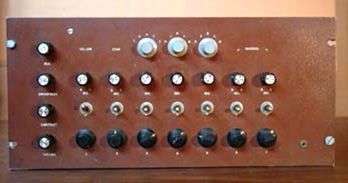
1973-74
Oscillators are designed by David Jones for use as signal inputs to the synthesizer, and as sonic modules. Initial research begins into the Jones gray level keyer and production of a black and white keyer. A commercially available Sony SEG is modified to accept direct sync interface with the Paik/Abe with provision for external wipe signal input.
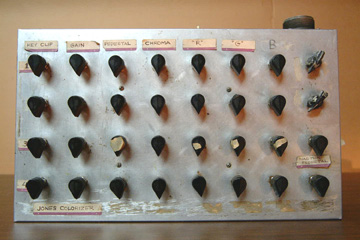
1974-75
David Jones develops the Jones Colorizer, a four channel voltage controllable colorizer with gray level keyers. In April 1975 the SAID (Spatial and Intensity Digitizer) is developed by Dr. Don McArthur, an outgrowth of research on black and white time base corrector. Work is begun by David Jones, Don McArthur and Walter Wright on a project to explore the interface of an LSI-11 computer with a video processing system. The goal is to create and control video imagery using a computer.
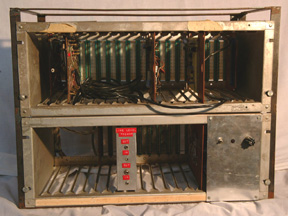
1975-76
The National Endowment for the Arts in 1975 provides support for initial research into the computer-video processing project, which is expanded by Jones, McArthur, Wright and Brewster to incorporate parallel research efforts by Woody and Steina Vasulka and Jeffrey Schier. The LSI-11 computer is the standard. Jones develops hard and soft edged keyers and a sequential switcher, which along with the Jones Colorizer, are incorporated into the processing system. A 64-point push button switching matrix is built, and used in dance performances with the American Dance Asylum and Bill T. Jones and Arnie Zane. We write a manual, which serves as an operator's guide to 1/2" reel-to-reel equipment, portapaks and editing equipment. Later we include construction information on a Paik Raster Control Unit. By 1985, the information is expanded to include systems structure and theory of electronic signals and processing techniques. These manuals have been distributed to many individuals and organizations over the years, and are now available on the Video History Web.
1976-77
The LSI-11 microprocessor is interfaced with video and audio synthesis equipment was installed as part of the system and made available to artists through the Residency Program; software research begins.
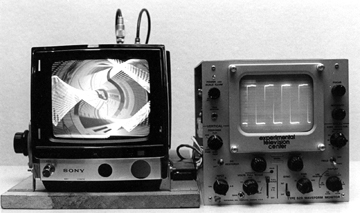
1977-78
The Analog Control Box is designed by David Jones and Richard Brewster, allowing the production of electronic sounds and also signals which controlled parameters of the video signal. The computer project proceeds, assisted by Paul Davis, then director of the student computer lab and instructor at the School for Advanced Technology at SUNY-Binghamton.
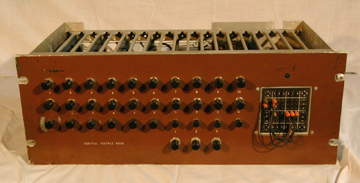
1979-80
We use a Z-2, an 8 bit computer with an S-100 bus, and dual floppy drives, as the digital device within the processing system. A CAT digital frame buffer is interfaced to the computer; at the time this is one of the only commercially available "low-cost" digital devices, which incorporated concepts of video, and recordable signal output. The Z-80 is interfaced also with the analog box. Software begins to be developed for specific video uses.
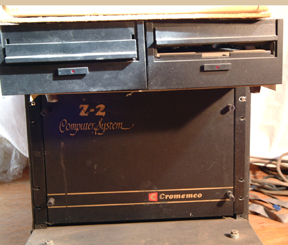
1980-81
The need for artist-oriented software increases. The Print Program is developed by David Jones, allowing artists to develop videographic still frames, captured on disk, then printed out with variable gray level control. This is a natural extension of the use of video image processing as an electronic darkroom for photographic techniques, an area that was explored by a number of artists at the Center since the early 70s. Additional software is developed by graduate-level interns under the direction of Paul Davis and Ralph Hocking.
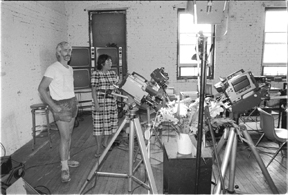
1982-83
The General Purpose Interface Board is designed to interface analog imaging equipment with an 8-bit computer, allowing manually-changed knob settings to be "remembered" and repeated digitally. David Jones and Peer Bode collaborate on the initial research for a real-time frame buffer, which digitizes in real time analog video images, with a resolution of 256x256, 16 shades of gray. The Pattern Program, a software project, is designed an internship project by Master's candidates at SUNY. Patterns or textures can be drawn and then stored and used as movable windows.
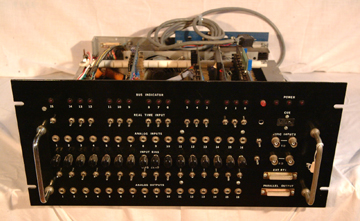
1983-84
Matt Schlanger and David Jones work on the Four Board Project, which consists of a four channel colorizer, keyers, multi-channel programmable sequencer, and oscillators. In addition to providing equipment for the Residency Program, one intention of the project is to define a comprehensive, low-cost imaging system and to then help artists to acquire or to build the tools. We begin to study the newly available Amiga computer.
1984-85
Matt Schlanger, Connie Coleman and Alan Powell document the Four Board Project. The equipment manual is revised to include the new tools, and to explicate such processes as keying, colorization, and switching.
1985-86
The Four Board Project is premiered at the Media Alliance Annual Conference at The Kitchen. David Jones and Peer Bode develop a black and white frame buffer by to be interfaced to the Amiga computer.
1986-87
The Print Program is revised for the Amiga. Customized software is devised to allow the computer to control the frame buffer. By 1988 a second Amiga is added to the system, one dedicated to buffer control, and one for videographics and audio software. We continue to work on educational strategies which help artists to become fluent on the computer and digital devises as quickly as possible.
1988-89
We begin work on
1990-91
A third Amiga and Toaster are added to the system.
1991-92
We begin a project to catalog antique equipment, artists' videotapes, print materials and audiotapes, using a computerized relational database. The project is inspired by our work for the Ars Electronica "Video Pioneers"exhibition at
1993-98
In 1994 we initiate the Video History Project, which documents the early historical development of video art. In partnership with the Institute for Electronic Arts at Alfred University and the New York State Alliance for Arts Education, the Experimental Television Center organizes "Video History: Making Connections" (Syracuse University, 1998). The Video History Web was premiered at the conference. The Tool Resource Room, co-organized by Hank Rudolph, David Jones, Ralph Hocking , Pamela Susan Hawkins and Peer Bode, displayed many early analog devices.
1999-00
With support from a Technology Grant from the New York State Council on the Arts, the system is expanded to include a G4 Mac with nonlinear editing and other image processing software. The Video History Project receives assistance from the New York Foundation for the Arts to assist with the planning process for revisions to the website. The site is formally launched Summer 2000.
2002-03
With assistance in 2003 from mediaThe foundation, we are able to significantly advance the digital components of the imaging system, incorporating a second G4 computer, other sonic and control modules by Doepfer, interactive software including Max/MSP and Jitter, as well as DVD authoring and editing software.

Sherry Miller Hocking, Owego November, 2003
Sherry Miller Hocking has worked with the Center since 1972. Since 1989 she has been Program Director for the Electronic Arts Grants Program, providing funding opportunities to individuals and media arts organizations. In 1993 she designed the Video History Project, a multi-faceted effort to reclaim the multiple histories of the independent media field, and serves as director of the Video History Web, an interactive site featuring extensive media and preservation resources and a contribution area. Visit us at http://www.experimentaltvcenter.org